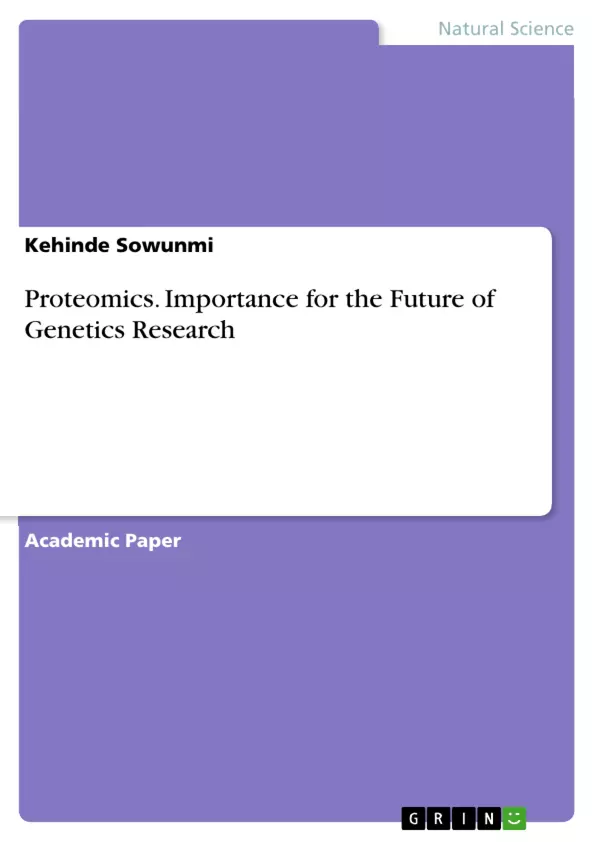A huge number of genes within the human genome code are proteins that mediate and/or control genetics processes. Although a large body of information on the number of genes, on chromosomal localisation, gene structure and function has been gathered, we are far from understanding the orchestrated way of how they make metabolism. Nevertheless, based on the genetic information emerging on a daily basis, we are offered fantastic new tools that allow us new insights into the molecular basis of human metabolism under normal as well as pathophysiological conditions. Recent technological advancements have made it possible to analyse simultaneously large sets of mRNA and/or proteins expressed in a biological sample or to define genetic heterogeneity that may be important for the individual response of an organism to changes in its nutritional environment. Applications of the new techniques of genome and proteome analysis are central for the development of nutritional sciences in the next decade and its integration into the rapidly developing era of functional genomics.
The proteome is the entire set of proteins that are produced or modified by an organism or system. This varies with time and distinct requirements, or stresses, that a cell or organism undergoes. Proteomics is an interdisciplinary domain that has benefitted greatly from the genetic information of the Human Genome Project; it also covers emerging scientific research and the exploration of proteomes from the overall level of intracellular protein composition, structure, and its own unique activity patterns. It is an important component of functional genomics.
While proteomics generally refers to the large-scale experimental analysis of proteins, it is often specifically used for protein purification and mass spectrometry. After genomics and transcriptomics, proteomics is the next step in the study of biological systems. It is more complicated than genomics because an organism's genome is more or less constant, whereas the proteome differs from cell to cell and from time to time. Distinct genes are expressed in different cell types, which means that even the basic set of proteins that are produced in a cell needs to be identified.
Inhaltsverzeichnis (Table of Contents)
- 1.0 INTRODUCTION
- 1.1 LIMITATIONS OF GENOMICS AND PROTEOMICS STUDIES
- 2.0 METHODS OF STUDYING PROTEINS
- 2.1 PROTEIN DETECTION WITH ANTIBODIES (IMMUNOASSAYS)
- 2.2 ANTIBODY-FREE PROTEIN DETECTION
- 3.0 CURRENT RESEARCH METHODOLOGIES
- 3.1 HIGH-THROUGHPUT PROTEOMIC TECHNOLOGIES
- 3.2 REVERSE-PHASED PROTEIN MICROARRAYS
- 4.0 PRACTICAL APPLICATIONS OF PROTEOMICS
- 4.1 INTERACTION PROTEOMICS AND PROTEIN NETWORKS
- 4.2 PROTEOGENOMICS
- 4.3 STRUCTURAL PROTEOMICS
- 4.4 COMPUTATIONAL METHODS IN STUDYING PROTEIN BIOMARKERS
- 5.0 EMERGING TRENDS IN PROTEOMICS
- 5.1 PROTEOMICS FOR SYSTEMS BIOLOGY
- 5.2 HUMAN PLASMA PROTEOME
Zielsetzung und Themenschwerpunkte (Objectives and Key Themes)
This work explores the field of proteomics, its significance in genetics research, and its evolving role in understanding complex biological systems. The paper delves into the methodologies used for protein analysis, highlighting the advancements in high-throughput technologies and the potential applications in various fields, including drug discovery, disease diagnostics, and systems biology.
- The role of proteomics in unraveling the complexities of protein functions and interactions within living organisms.
- The limitations of genomics and the need for proteomic approaches to gain a more comprehensive understanding of cellular processes.
- The various methods employed in proteomics, including protein detection techniques, mass spectrometry, and high-throughput technologies.
- The practical applications of proteomics, particularly in the areas of disease diagnostics, drug discovery, and understanding protein networks.
- Emerging trends in proteomics, such as its integration into systems biology and the study of the human plasma proteome.
Zusammenfassung der Kapitel (Chapter Summaries)
The introduction lays out the foundation for proteomics, defining it as the large-scale study of proteins and their roles in living organisms. It highlights the significance of proteomics in complementing genomics and provides a historical context of its development.
Chapter 1.1 delves into the limitations of genomics and why proteomic approaches are necessary. It discusses the complexities of protein expression and regulation, emphasizing the role of post-translational modifications and protein-protein interactions.
Chapter 2 focuses on the methods employed in proteomics. It explores both antibody-based and mass spectrometry techniques for protein detection and quantification, highlighting the importance of specific antibodies and biochemical separation for complex biological samples.
Chapter 3 examines current research methodologies in proteomics, including high-throughput technologies and reverse-phased protein microarrays. These advanced techniques allow for the simultaneous analysis of large sets of proteins and provide insights into the intricate workings of cellular systems.
Chapter 4 explores the practical applications of proteomics in various fields. It examines the role of proteomics in understanding protein networks, its application in drug discovery, and its contribution to structural proteomics.
Schlüsselwörter (Keywords)
Proteomics, genomics, genetics research, protein analysis, mass spectrometry, high-throughput technologies, protein networks, systems biology, human plasma proteome, disease diagnostics, drug discovery, post-translational modifications.
- Quote paper
- Kehinde Sowunmi (Author), 2020, Proteomics. Importance for the Future of Genetics Research, Munich, GRIN Verlag, https://www.hausarbeiten.de/document/517924


